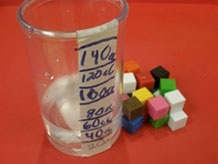What happens when we add earth materials to water?
2. Explore volumes in water

Distribute a tray of materials to each group. Point out that the graduated cylinders are the same "measuring cups" that the students made to measure water volumes in an earlier investigation.
Ask students to open their notebooks [What happens when we add earth materials to water?] and review the list of materials they will add to water in their graduated cylinders: centimeter cubes, water, rocks, and gravel. Explain that they will investigate one material at a time, and that they will start with a fresh measure of water (40cc) each time they change materials. They can work in pairs.
Before students get to work, remind them to predict how much the water level will rise with the addition of each material. Students can make their predictions in their notebooks, or they can make predictions with their partners. In either case, they should explain their reasoning. Model this kind of conversation with a volunteer:
- What do you predict will happen when we put 10 centimeters cubes in 40 cubic centimeters of water?
- I predict that when I put 10 centimeter cubes in the water the water level will rise to 50 cubic centimeters.
- Why do you think so?
- Because the water and the cubes can't be in the same place at the same time, and the cubes will push the water up.
The investigation is straightforward. Students add measured volumes of material to 40cc of water and observe the change in volume in the graduated cylinder. The results for the first three tests are straightforward, too. The combined volume is equal to the sum of the separate volumes.
But the gravel is a different story. When students add 40cc of gravel to 40cc of water, the combined volume is considerably less than the sum of the two.
40cc water + 40cc bulk gravel = approx. 65cc combined volume in the cylinder
As you circulate among the groups, see how students are grappling with this result.
What's going on with the gravel? When 40cc of bulk gravel are added to 40cc of water, the resulting volume in the graduated cylinder is considerably less than 80cc. A portion of the volume of granular materials is air in the "empty spaces" between the grains. That air escapes the container when the material is added to water.



